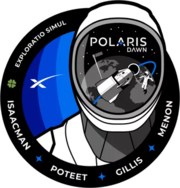 | |
| Mission type | Private spaceflight |
|---|---|
| Operator | SpaceX |
| COSPAR ID | 2024-161A |
| SATCAT no. | 61042 |
| Website | polarisprogram |
| Mission duration | 4 days, 22 hours and 13 minutes |
| Orbits completed | 75 |
| Spacecraft properties | |
| Spacecraft | Crew Dragon Resilience |
| Spacecraft type | Crew Dragon |
| Crew | |
| Crew size | 4 |
| Members | |
| EVAs | 1 |
| EVA duration | 26 minutes[1] |
| Start of mission | |
| Launch date | 10 September 2024, 09:23:49 UTC (5:23:49 am EDT)[2] |
| Rocket | Falcon 9 Block 5 (B1083.4), Flight 372 |
| Launch site | Kennedy, LC‑39A |
| End of mission | |
| Recovered by | MV Shannon |
| Landing date | 15 September 2024, 07:36:54 UTC (3:36:54 am EDT)[3] |
| Landing site | Gulf of Mexico near Dry Tortugas (25°06′N 83°00′W / 25.1°N 83.0°W) |
| Orbital parameters | |
| Perigee altitude | 190–192 km (118–119 mi)[4][5] |
| Apogee altitude | |
| Inclination | 51.7°[4] |
| Period | 106 minutes[7] |
 Mission patch  From left: Isaacman, Menon, Gillis and Poteet | |
Polaris Dawn was a private crewed spaceflight operated by SpaceX on behalf of Shift4 CEO Jared Isaacman, the first of three planned missions in the Polaris program. Launched 10 September 2024 as the 14th crewed orbital flight of a Crew Dragon spacecraft, Isaacman and his crew of three — Scott Poteet, Sarah Gillis and Anna Menon — flew in an elliptic orbit that took them 1,400 kilometers (870 mi) away from Earth, the farthest anyone has been since NASA's Apollo program. They passed through parts of the Van Allen radiation belt to study the health effects of space radiation and spaceflight on the human body. Later in the mission, the crew performed the first commercial spacewalk.
The Polaris Dawn mission also marked several other milestones. Menon and Gillis flew further from Earth than any women before them and Gillis, at 30 years old, became the youngest person to date to participate in a spacewalk. During the spacewalk, a new record was set for the number of people (four) simultaneously exposed to the vacuum of space. The crew also contributed to breaking the record for the most people (19) simultaneously in orbit, set after the Soyuz MS-26 mission launched on 11 September along with the nine crew members of the International Space Station and the three crew members of China's Tiangong space station.
After a mission lasting nearly five days, the crew safely splashed down in the Gulf of Mexico on 15 September.
- ^ McDowell, Jonathan (12 September 2024). "List of spacewalks". planet4589.org. Retrieved 12 September 2024.
- ^ Cite error: The named reference
nsf20240910was invoked but never defined (see the help page). - ^ "Polaris Dawn Crew Returns to Earth, Achieving Major Objectives During Their Five-Day Mission". 15 September 2024.
- ^ a b c McDowell, Jonathan [@planet4589] (10 September 2024). "Polaris Dawn cataloged as object 61042, in a 195 x 1200 km x 51.7 deg orbit" (Tweet). Retrieved 10 September 2024 – via Twitter.
- ^ a b Cite error: The named reference
Day 2 orbitwas invoked but never defined (see the help page). - ^ Cite error: The named reference
Day 1 orbitwas invoked but never defined (see the help page). - ^ Cite error: The named reference
OverviewBriefing20240819was invoked but never defined (see the help page).